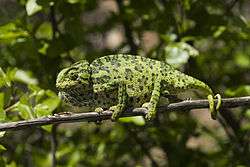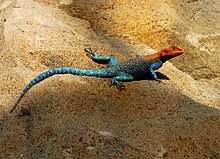Acrodonta (lizard)
Acrodonts are a subclade of iguanian squamates consisting almost entirely of Old World taxa. Extant representation include the families Chamaeleonidae (chameleons) and Agamidae (dragon lizards), with at least over 500 species described. A fossil genus, Gueragama, was found in Brazil, making it the only known American representative of the group.[1]
| Acrodonta | |
|---|---|
 | |
| Common chameleon, Chamaeleo chamaeleon | |
 | |
| Common Agama Agama agama | |
| Scientific classification | |
| Kingdom: | Animalia |
| Phylum: | Chordata |
| Class: | Reptilia |
| Order: | Squamata |
| Suborder: | Iguania |
| Clade: | Chamaeleontiformes |
| Clade: | Acrodonta Cope, 1864 |
| Subclades | |
| |
The group is eponymously named from the formation of the teeth whereby the teeth are consolidated with the summit of the alveolar ridge of the jaw without sockets.[2] There are, however, other animals that have acrodont dentition such as tuataras.[3].
Systematics
Usually acrodonts are divided into two families Chamaeleonidae and Agamidae, there are a few studies that suggest chameleons are nested within Agamidae.[4][5] In order to maintain the familial status of Chamaeleonidae some authors suggested placing the clades Uromastycinae and Leiolepidinae in a third family Leiolepididae.[4][5] However a majority of papers concerning acrodont phylogenetics support the traditional dichotomy of the group.[6][7][8][9]
Below is the phylogeny of the acrodont lineages after Pyron et al. (2013):[8]
| Acrodonta |
| ||||||||||||||||||||||||||||||||||||||||||
References
- Simões, Tiago R.; Wilner, Everton; Caldwell, Michael W.; Weinschütz, Luiz C.; Kellner, Alexander W. A. (26 August 2015). "A stem acrodontan lizard in the Cretaceous of Brazil revises early lizard evolution in Gondwana". Nature Communications. 6: 8149. Bibcode:2015NatCo...6.8149S. doi:10.1038/ncomms9149. PMC 4560825. PMID 26306778.
- Plough, F. H. et al. (2002) Vertebrate Life, 6th Ed. Prentice Hall Inc., Upper Saddle River, NJ. ISBN 0-13-041248-1
- Edmund, A. G. (1969). "Dentition". Biology of the Reptilia. 1: 117–200. Retrieved 16 August 2017.
- Honda M, Ota H, Kobayashi M, Nabhitabhata J, Yong HS, Sengoku S, Hikida T (2000). "Phylogenetic Relationships of the Family Agamidae (Reptilia: Iguania) Inferred from Mitochondrial DNA Sequences". Zoological Science. 17 (4): 527–537. doi:10.2108/zsj.17.527. hdl:2433/57223.
- Jacques A. Gauthier; Maureen Kearney; Jessica Anderson Maisano; Olivier Rieppel; Adam D.B. Behlke (2012). "Assembling the Squamate Tree of Life: Perspectives from the Phenotype and the Fossil Record". Bulletin of the Peabody Museum of Natural History. 53 (1): 3–308. doi:10.3374/014.053.0101.
- Moody, S. M. (1980). Phylogenetic relationships and historical biogeographical relationships of the genera in the family Agamidae (Reptilia: Lacertilia) (Ph.D. Dissertation). Ann Arbor: University of Michigan.
- Frost, Darrel R.; Richard Etheridge (28 September 1989). "A phylogenetic analysis and taxonomy of iguanian lizards (Reptilia: Squamata)". University of Kansas Museum of Natural History Miscellaneous Publications. University of Kansas Museum of Natural History. 81: 1–65. Retrieved 5 January 2012.
- Pyron; Burbrink; Wiens (2013). "A phylogeny and revised classification of Squamata, including 4161 species of lizards and snakes". BMC Evolutionary Biology. 13: 93. doi:10.1186/1471-2148-13-93. PMC 3682911. PMID 23627680.
- Zheng, Yuchi; Wiens, John J. (2016). "Combining phylogenomic and supermatrix approaches, and a time-calibrated phylogeny for squamate reptiles (lizards and snakes) based on 52 genes and 4162 species". Molecular Phylogenetics and Evolution. 94 (Pt B): 537–547. doi:10.1016/j.ympev.2015.10.009. PMID 26475614.